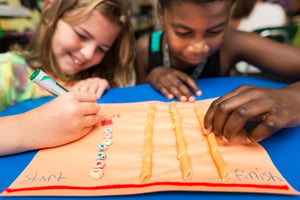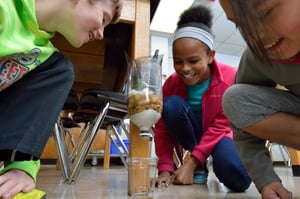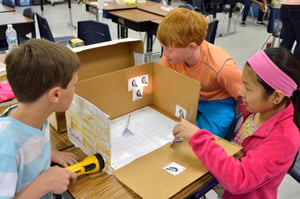 State tests are right around the corner, and educators are working hard to remind their students of everything they’ve learned this year. That’s no easy feat! The recent Edutopia article “Why Students Forget—and What You Can Do About It” suggests “making as many connections as possible—typically to other concepts” to keep lessons fresh in students’ minds. Most students won’t make these connections on their own, so it’s important for educators to make these connections explicit. An engineering design challenge can be an effective (and fun!) way to make explicit connections to math concepts and strengthen students’ math skills. As students walk through the engineering design process, excited to design and improve their own technologies, educators can encourage students to productively use math to solve the problem. Below, we highlight EiE units that have strong math connections to demonstrate how educators can reinforce math concepts in a way that will stick.
State tests are right around the corner, and educators are working hard to remind their students of everything they’ve learned this year. That’s no easy feat! The recent Edutopia article “Why Students Forget—and What You Can Do About It” suggests “making as many connections as possible—typically to other concepts” to keep lessons fresh in students’ minds. Most students won’t make these connections on their own, so it’s important for educators to make these connections explicit. An engineering design challenge can be an effective (and fun!) way to make explicit connections to math concepts and strengthen students’ math skills. As students walk through the engineering design process, excited to design and improve their own technologies, educators can encourage students to productively use math to solve the problem. Below, we highlight EiE units that have strong math connections to demonstrate how educators can reinforce math concepts in a way that will stick.
Look Out Below
In our aerospace engineering unit, A Long Way Down: Designing Parachutes, students are tasked with designing “mission ready” model parachutes to deploy on other planets. Students need to account for the size of their payloads and the planet’s atmosphere in their designs, which requires them to apply several key math skills. In their design challenge, they’ll need to measure the radius and diameter of their parachute canopies; measure suspension line lengths, drop heights, and drop speeds; and calculate the average drop speed from multiple trials. Best of all, their hard work pays off with a super-fun testing procedure—check out the video below!
First Rate
 Students may have a difficult time grasping the concept of rate calculation without understanding how it is applied in the real world. Two of our environmental engineering units; Water, Water Everywhere: Designing Water Filters and Just Passing Through: Designing Model Membranes; challenge students to calculate the rate of dripping water. In Water Filters, they’ll design a water filter that protects a turtle from polluted water, and in Model Membranes, they’ll design a model membrane that keeps a frog moist. They’ll also get the chance to practice measuring liquids using standard units as they apply their math skills to help animals in need.
Students may have a difficult time grasping the concept of rate calculation without understanding how it is applied in the real world. Two of our environmental engineering units; Water, Water Everywhere: Designing Water Filters and Just Passing Through: Designing Model Membranes; challenge students to calculate the rate of dripping water. In Water Filters, they’ll design a water filter that protects a turtle from polluted water, and in Model Membranes, they’ll design a model membrane that keeps a frog moist. They’ll also get the chance to practice measuring liquids using standard units as they apply their math skills to help animals in need.
What’s Your Angle?
 In our lighting and optical engineering unit, Lighten Up: Designing Lighting Systems, students are tasked with designing a system to illuminate hieroglyphics in a model tomb. They utilize mirrors and flashlights to direct the path of light to the correct area of the tomb, which requires them to apply their knowledge of angles, symmetry, geometry, and quantitative reasoning. Students will also get invaluable practice with math tools as they measure the perfect angle for their mirrors with protractors.
In our lighting and optical engineering unit, Lighten Up: Designing Lighting Systems, students are tasked with designing a system to illuminate hieroglyphics in a model tomb. They utilize mirrors and flashlights to direct the path of light to the correct area of the tomb, which requires them to apply their knowledge of angles, symmetry, geometry, and quantitative reasoning. Students will also get invaluable practice with math tools as they measure the perfect angle for their mirrors with protractors.
Whether you’re teaching one of our EiE units or conducting your own engineering design challenge, make sure that the students use their knowledge and skills in meaningful ways that will contribute to their overall understanding of each subject. If you're interested in learning more about the math connections in all of our units, check out our handy guide to Common Core math standards, or take a look at our classroom video library to see educators making math connections crystal clear for their students.








